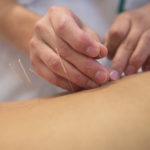Hernia, Inguinal

What is an inguinal hernia?
An inguinal hernia occurs when part of the “sac” that lines the abdomen pushes through a weak spot in the inguinal canal (an opening between layers of abdominal muscle near the groin between the abdomen and inner thigh). This abnormal bulge can typically be seen and felt, especially when one “bears down,” that is, increases abdominal pressure by holding one’s breath and pushing, coughing or sneezing.
What are the top inguinal hernia symptoms?
With an inguinal hernia, there is a soft bulge in the groin area or a swelling in the scrotum with or without pain that is usually reducible (able to be pushed back through the area of weakness). Hernias can often be diagnosed on examination by simply placing a hand or finger over the area and having the patient bear down or cough. Very small hernias usually contain only fluid from the abdominal cavity, while a loop or part of bowel will occasionally be pushed into the bulge of medium or large hernias and cause discomfort. Pain can worsen with repeated heavy lifting or straining. Nausea, vomiting, severe pain and/or absence of bowel movements may indicate an incarcerated hernia, which occurs if the intestine cannot be pushed back through the area of muscle. This can be a potentially life-threatening condition that requires immediate surgical intervention to prevent the trapped part of bowel from dying from loss of blood supply.
What are the causes of inguinal hernias?
The majority of people who get inguinal hernias are men born with a weakness in the abdominal wall, and 90 percent of newborns diagnosed with inguinal hernias are boys. Most often this occurs when a muscle in the abdominal wall does not close as it should during fetal development, therefore causing a weakness that allows tissue to protrude with abdominal pressure. Anything that causes increased pressure on the abdominal wall can cause a herniation (bulging) through this weakness in the muscle. People who are overweight are much more likely to get an inguinal hernia, especially if they smoke and have a chronic cough. Weightlifters and people who do heavy lifting in their line of work are also at risk for inguinal hernias. Women who are pregnant are also at greater risk due to the abdominal pressure and weight gain associated with pregnancy, as well as those with allergies who have chronic coughing and sneezing. Straining to have a bowel movement or even to pass urine, as in men with enlarged prostates, can cause enough pressure to produce this bulge in the groin as well
What is the conventional treatment for an inguinal hernia?
Although a hernia will not “repair” itself with rest, if the symptoms are tolerable and the bulge can be pushed back (reduced), one may choose to simply avoid activities that aggravate it like heavy lifting or straining. A belt can be worn for extra support to the area. If this is not an option, the conventional treatment for an inguinal hernia is surgical repair. This can be done laparoscopically or by an open incision in the abdominal wall. Laparoscopic surgery is typically done on an outpatient basis, involves a telescope-like instrument that requires small abdominal incisions for the surgical instruments and the scope, is minimally invasive and requires a relatively short recovery time when compared with open repair through an incision. Some surgeons choose to reinforce the area with steel mesh or wire, called hernioplasty, which helps prevent recurrence. If the hernia has become incarcerated or strangulated, a bowel resection will most likely be performed to remove the area of damaged intestine. This can usually be done through the laparoscope. Although surgical interventions are highly successful, there is no guarantee the hernia will not return. Recurrence rates are higher in those who have the procedure laparoscopically and those who do not get the steel mesh reinforcement.
What therapies does Dr. Weil recommend for an inguinal hernia?
Dietary changes: If you battle with chronic constipation, work on getting enough fiber, drinking plenty of water, and if necessary using bulk-agents like Metamucil and Citrucel.
Exercise: If you need to lose weight, employ both prudent caloric intake (using the anti-inflammatory diet) and moderate physical exercise that does not place undue stress on the abdominal wall. Ask a physical therapist for guidance on exercises that fit your unique condition.
Supplements: Address allergies (to avoid chronic sneezing and coughing that can strain the abdominal wall) with natural agents like freeze-dried stinging nettles and quercetin, or use antihistamines and other conventional medications to control symptoms if necessary. For constipation, Dr. Weil recommends triphala, a mixture of three fruits from the Ayurvedic tradition of India. It helps to regulate bowel function and is available in capsule form at health food stores. A low dose of magnesium glycinate may also be helpful for chronic constipation.
Also:
Obviously, the best therapy for inguinal hernias is to avoid getting one in the first place. Because chronic pressure on a weakened abdominal wall is the primary cause of inguinal hernias, you should do all you can to avoid risk factors that cause this.
If you have a chronic cough due to smoking, quit!
Regarding surgical repair of a hernia, one simple adjunct that can help ensure a good outcome is vitamin C, either in IV fluids or taken orally. You can try to convince your surgeon to mix vitamin C with the intravenous fluids you’ll get in the operating room: ask for 20 grams of vitamin C in every 24-hour period. The body uses a lot of vitamin C to make and repair connective tissue. A high intake of C has been shown to help speed the healing of surgical wounds. Your surgeon may resist, but press your case. The results will be worth it. If you can’t do this, increase oral intake of vitamin C to 1,000 mg twice a day until and after surgery.
Be sure that your anesthesiologist is aware of all supplements and drugs you are taking, especially blood thinners such as aspirin or other anticoagulant drugs, including high doses of fish oil, garlic, and vitamin E, all of which have anticoagulant effects. Dr. Weil also suggests making a tape of healing statements to be played while you’re under anesthesia and using guided imagery tapes both before and after surgery. You may want to look into taking the “Prepare for Surgery” program by psychologist Peggy Huddleston or listening to affirming tapes made by psychotherapist Belleruth Naparstek and available via her website: www.healthjourneys.com. More than 200 studies have shown that guided imagery can make a huge difference to surgical patients by decreasing pain and the need for pain medication, reducing side effects and complications of surgery, lessening stress and anxiety before and after procedures, reducing recovery time, improving sleep, strengthening the immune system, and boosting self-confidence and self-control.
Finally, you may also be able to shorten your recovery time after surgery for an inguinal hernia by taking cordyceps, a Chinese tonic mushroom, along with bromelain, a pineapple enzyme that can reduce swelling and bruising; take 200-400 mg three times a day on an empty stomach. Homeopathic arnica may help with pain; use the 30c potency and take five tablets as directed every two to four hours as needed for the first 48 hours after surgery.









